Tabbouleh
Recipes for tabbouleh vary from region to region, but this is our go-to from the master of cooking from the Levant .
Recipe supplied by Anissa Helou, anissas.com
Serves 8
30g fine bulgur wheat
600g firm ripe tomatoes, diced into small cubes
50g spring onions, trimmed and very thinly sliced
400g flat-leaf parsley, most of the stalk discarded, very finely chopped
70g mint, leaves only, very finely chopped
¼ tsp ground cinnamon
½ tsp ground allspice/Lebanese seven-spice mix
¼ tsp finely ground black pepper
Salt to taste
Juice of 1 lemon, or to taste
150ml extra virgin olive oil
4 gem lettuce, washed and quartered
1 Rinse the bulgur in several changes of cold water. Drain well and put in a bowl. Stir it with a fork every now and then to help fluff it up.
2 Drain the diced tomatoes, then put in a bowl. A word of warning: do not chop the herbs with a mezzaluna. This will only bruise them. Instead, use a razor-sharp knife, gather as much as you can handle in a bunch and slice them very thin to end up with nice, crisp thin strips. Add the spring onion and herbs. Sprinkle the bulgur all over. Season with the cinnamon, allspice and pepper. Add salt to taste, then lemon juice and olive oil. Mix well. Taste and adjust the seasoning if necessary. Serve immediately with the quartered gem lettuce.
English pesto
This simple pesto has been our lunchbox saviour of late – try it in a packed lunch. You can use this variation in sandwiches, salad dressings, soups and pasta.
The Little Book of Lunch, Sophie Missing and Caroline Craig (Square Peg)
Makes one small jar
2 tbsp pine nuts
4 tbsp finely grated Berkswell or parmesan cheese
2 handfuls fresh parsley
1 tbsp extra-virgin olive oil
1 Toast the pine nuts until golden, then put in a jug or bowl with the rest of the ingredients and blitz with a hand blender until smooth.
Uchucuta sauce with lamb chops

Uchucuta is the Peruvian equivalent of Argentinian chimichurri. It's great with any meat, but we'd recommend grilled lamb chops.
Recipe supplied by Martin Morales, Ceviche
Serves 6
150g feta
1 tbsp olive oil, plus extra for grilling
1 tbsp chilli paste
2 tbsp single cream
A bunch of flat-leaf parsley, leaves finely chopped
A small handful of coriander leaves, finely chopped
A small handful of mint leaves, finely chopped
A small handful of tarragon, leaves finely chopped
50g sweetcorn kernels
Salt and black pepper
12 lamb chops
1 Crumble the cheese into a mixing bowl, then add the olive oil, chilli paste, cream and herbs.
2 In a small frying pan, cook the sweetcorn in a little oil until browned, then add the cheese and herbs with a big pinch of salt. Mix well then whizz in a food processor or blender to a smooth sauce. Add more cream if needed to achieve a smooth consistency, then set aside.
3 Heat the grill to medium high. Brush the lamb chops with a little oil, season well, then grill for 3-4 minutes, or to taste, on each side (depending on the thickness, the chops will be medium-rare after this time). Rest for a couple of minutes, then serve with the sauce.
Parsley gnocchi with goat's curd and hazelnuts
The balance of parsley's grassy notes with the creamy curd and aromatic hazelnuts is a real winner. Try it with a mild soft goat's cheese if you can't find curd.
Recipe supplied by Sophie Michell, Pont St Restaurant, thompsonhotels.com
Serves 4
For the gnocchi
1kg floury potatoes, eg King Edwards, scrubbed
1 large bunch flat-leaf parsley
1 egg, beaten
300g flour
50g butter
Salt and black pepper
To serve
200g butter
4 banana shallots, finely diced
100g hazelnuts, chopped
Fresh goat's curd or goat's cheese, to taste
1 Preheat the oven to 200C/400F/gas mark 6. Put the potatoes on a baking tray and bake in the oven for 1 hour, or until cooked through. Blanch the parsley in boiling water, refresh and blitz to a puree.
2 Remove the potatoes from the oven. When cool enough, cut them in half and scoop the flesh into a bowl. Keeping the potato covered with a tea towel so it doesn't dry out and go hard, gradually pass it through a coarse sieve, potato ricer or a mouli into a large bowl. Add the egg, pureed parsley, flour, butter, salt and pepper to the sieved potato and mix into a soft dough. Be careful not to overwork the dough, as it will go gluey and tough.
3 Bring a large saucepan of lightly salted water to a rapid boil. Roll the dough on a lightly floured surface into sausage shapes roughly 2.5cm wide, then cut into 2.5cm pieces and lay on a floured plate.
4 Add half the gnocchi to the saucepan of boiling water, cook for 5 minutes, then drain. Repeat with the remaining gnocchi.
5 When you are ready to eat, heat up a large frying pan and add the butter and shallots. Fry until translucent then add the hazelnuts. Continue to fry for a few minutes until the butter is foaming, then add the gnocchi. Cook for 8-10 minutes until browning, puffy and warmed through. Season well and spoon into a bowl, then dot with goat's curd. Get the guests to stir in the goat's curd when ready to eat and tuck in.
Lemon curd and parsley meringue pie

We're sold on the parsley in this pudding – it adds a little bit of intrigue to a favourite.
Recipe supplied by Andrew Dargue, Vanilla Black
Serves 4
2 egg whites
A pinch of salt
100g caster sugar
1 tbsp fresh parsley, very finely chopped
4 good quality shortbread biscuits (you can make your own if you prefer)
Good quality lemon curd
1 Heat the oven to 140C/275F/gas mark 1.Place the egg whites in the bowl of a electric mixer, making sure it is very clean, and whisk on high. As it starts to expand, add a pinch of salt to stabilise it.
2 Add 1 tsp sugar and continue mixing; repeat. Adding the sugar slowly helps to prevent the meringue collapsing. Continue whisking and adding until the sugar is all used up and the meringue has formed. Finally add the parsley and mix in. Pipe into small rosettes about the size of a 10p on to a baking tray lined with baking paper.
3 Bake on the middle shelf of the oven for 40 minutes, then remove and place on a wire rack to cool. Store in an airtight container. They will probably only last a day as they absorb moisture from the air very quickly.
4 To serve, spoon a little lemon curd on to a plate and glue each biscuit in place. Spread lemon curd on top of each biscuit. Finally put the meringues on top and serve with a little whipped cream.
Buttered parsley pilaf with peppered hake
We love Simon Hopkinson's twist on the classic white fish and parsley sauce. Don't be shy with the butter.
Simon Hopkinson Cooks (BBC Books)
Serves 4
For the buttered parsley pilaf
12 ice cubes
1 bunch of curly parsley (the larger ones found in the supermarkets), coarser stems discarded
80g butter
1 small garlic clove, crushed
4 spring onions, trimmed and finely chopped
200g basmati rice
320ml water
Salt and freshly ground white pepper
For the hake
1 tbsp white peppercorns
1 tbsp black peppercorns
4 hake cutlets – about 200g each
A little flour
Salt
2 tbsp olive oil
25g butter
2 tbsp cognac
4 tbsp strong, well-flavoured chicken stock
1 tbsp double cream
A squeeze of lemon juice
1 First, prepare the hake. Using a coffee grinder, or similar, coarsely grind the peppercorns, then put into a sieve and shake off excess fine powder which, if included, will make the dish far too hot. Now sprinkle the pepper over one surface of the hake cutlets, press in well and put to one side on a plate.
2 To make the pilaf, preheat the oven to 180C/350F/gas mark 4. Fill a large bowl with cold water and then add the ice cubes.
2 Bring a large pot of salted water to a rolling boil and plunge in the parsley sprigs. Bring almost back to a boil, then strain through a sieve over the sink. Refresh in iced water and stir it around a bit. Leave there for a couple of minutes, strain and squeeze dry.
3 Now, melt 50g of the butter then allow to cool for a minute or two. Pour into a small food processor, add the parsley and garlic to it then process together until very smooth and a vivid green. Put to one side, still in the processor bowl.
4 Melt the remaining butter in a roomy pot with a tight-fitting lid. Add the spring onions and cook gently without colouring them. Tip in the rice and stir around in the butter and spring onions until well coated. Pour in the water and slowly bring up to a simmer. Add a little salt and pepper and, once the rice is simmering, put on the lid and slide into the oven. Cook for 15 minutes.
5 Meanwhile, lightly dust the peppered side of the hake cutlets with flour and season with salt. Put the oil and the butter in a large frying pan and, when just beginning to froth, slide in the cutlets, peppered-side down. Cook for about 3–4 minutes and then carefully turn over. Continue cooking for a few minutes more, or until the central bone of the fish may be eased away from the flesh. Peel off the skin, then remove to a serving dish, cover with foil and keep warm.
6 Remove the pilaf from the oven. Don't lift off the lid and leave to sit for 5 minutes. Now take off the lid and stir in the buttery parsley puree until the entire pot of rice is a gorgeous green. Now lay a tea towel over the pan and then clamp the lid on with the lid. Rest for another 5 minutes, allowing the rice to steam, which will be absorbed by the towel.
7 To finish the hake, pour the cognac into the frying pan, allow it to bubble for a few minutes, then add the stock. Over a medium heat, stir together and reduce until syrupy. Now pour in the cream and stir once more to make a smooth sauce. Add a small squeeze of lemon juice to finish. Take the foil off the fish, and tip any fishy juices into the sauce. Stir in and pour over the cutlets. Finally, remove the lid and towel from the pilaf, stir once more then serve with the hake.
Broad bean, blue cheese and parsley pizzas
Darina Allen's beautifully green pizza encapsulates early spring. We love the sauce tossed through pasta with parmesan, too.
Recipe adapted from 30 Years at Ballymaloe, Darina Allen (Kyle Books)
Makes 4
For the pizza dough
450g strong white bread flour
7g sachets fast active yeast
10g salt
275ml cold tap water
Semolina, for sprinkling
For the fennel sauce
1 tbsp extra virgin olive oil
2 onions, thinly sliced
3 garlic cloves, peeled and crushed
5 bulbs of fennel, thinly sliced
600ml water
Salt and black pepper
To serve
100g broad beans, fresh or frozen
4 tsp extra virgin olive oil
Salt
32 cubes of blue cheese – about 1cm each
Four large handfuls of grated mozzarella
Large handful of fresh flat-leaf parsley, finely chopped
Lemon wedges
1 To make the pizza dough, combine the flour, yeast and salt, make a well in the centre then pour in the water, mixing to a dough. Knead on a floured surface until smooth and elastic – around 10 minutes – then put in a clean, oiled bowl covered with clingfilm and leave to rise in a warm place for around an hour, until doubled in size.
2 Meanwhile, make the fennel sauce. Heat the oil in a pan, add the onions and garlic and sweat until soft but not coloured. Add the fennel slices and water, season with salt and pepper, then simmer for about 25 minutes, or until soft. Blend until smooth. Taste and correct the seasoning, if necessary.
3 Preheat the oven to 240C/475F/gas 9. Blanch the broad beans in boiling water for 2 minutes. Drain, refresh under cold water and set aside.
4 Divide the dough into 4 pieces, then roll out each piece to form a 25cm disc. Sprinkle a little semolina all over the surface of a pizza stone or baking tray then put the pizza base on top. Drizzle the olive oil over the base of the pizza and sprinkle with a pinch of salt. Spread about 150ml of the fennel sauce over each base. Scatter the beans and cheese cubes on top and sprinkle with the mozzarella.
5 Bake each pizza for 10–12 minutes (you'll need to do this in batches), or until the base is crisp and the top is golden. Sprinkle with parsley and serve with lemon wedges.
Parsley and paprika tempura
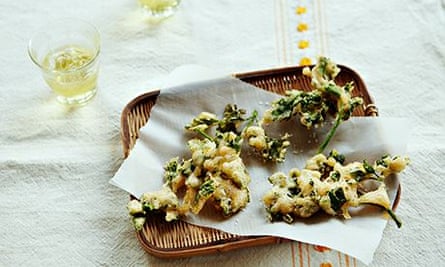
Try serving this as a pre-dinner snack with a glass of dry sherry or an ice-cold lager.
Recipe supplied by Josep Carbonell, Brindisa
Serves 6-8
Vegetable oil, for frying
150g tempura flour mix
½ tsp paprika
150g sparkling water
6 sprigs parsley (cut the stalk; leave just 1cm of it)
Maldon salt
1 Heat a wok ⅓ full of vegetable oil, or pour the oil into a deep-fat fryer. Heat to 180C/350F or until a breadcrumb sizzles and turns golden-brown after 30 seconds.
2 Mix the flour, paprika and water and stir to make the tempura mix. Dip the parsley leaves into the mix. Drain on kitchen paper, sprinkle with salt to taste then serve immediately.
Ham with parsley sauce
Fergus Henderson's simple but delicious main is a classic with very good reason. I believe it is important to have the parsley sauce in a jug on the table so the eaters can express themselves with their pouring. When buying your ham, avoid pink things in hairnets. Look for organic and free-range if possible. It is always good to cook a bit more than you will eat so you can have cold ham.
Complete Nose to Tail by Fergus Henderson (Bloomsbury)
2kg piece rolled green collar of good-quality ham
2 sticks celery
2 onions, peeled and stuck with 8 cloves
2 leeks, cleaned
3 bay leaves
10 black peppercorns
10 good-sized carrots, peeled but left whole; this way they stay sweeter
For the parsley sauce
100g butter
100g flour
600ml milk
Salt and black pepper
A big bunch of curly parsley, finely chopped
1 Place the ham in a pot, leaving room for your carrots. Cover with water, then add the celery, onions, leeks, bay leaves and peppercorns. Bring gently to the boil, skim, then reduce to a simmer for 2½ hours. Add your carrots.
2 Now make the sauce. Melt the butter in a pan, add the flour and stir on a gentle heat – do not let it colour. When it smells biscuity, add the milk, whisking ferociously, making sure the heat's not too fierce. When you have a firm, white, creamy mixture, add a ladle of ham stock and whisk again. Do this until you have reached your desired consistency. Test for seasoning. Just before serving add the chopped parsley and stir.
3 When the carrots are cooked, about 5-10 minutes, you are ready to serve (if the ham is cooked and the carrots are not, remove the ham from the water and turn up the heat). Slice the ham and serve on a plate with carrots and lots of the parsley sauce. Mustard is vital on the table. You will be left with delicious ham stock for another day, and cold ham for your sandwiches.
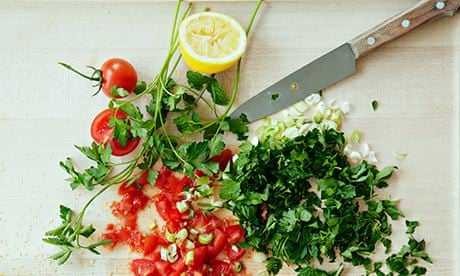
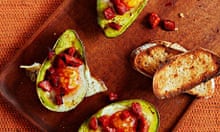



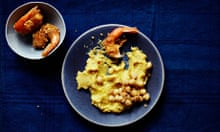

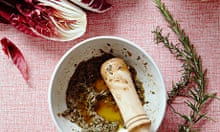
Comments (…)
Sign in or create your Guardian account to join the discussion